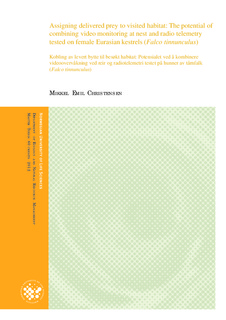Assigning delivered prey to visited habitat : the potential of combining video monitoring at nest and radio telemetry tested on female Eurasian kestrels (Falco tinnunculus)
Master thesis
Permanent lenke
http://hdl.handle.net/11250/186933Utgivelsesdato
2012-10-03Metadata
Vis full innførselSamlinger
- Master's theses (INA) [593]
Sammendrag
In this study I used a combination of video monitoring and high intensity radio telemetry to assign specific prey items to habitat visited by female Eurasian kestrels (Falco tinnunculus) during the breeding season of 2011 in Trysil, eastern Norway. I used the combined dataset comprising 63 locations reliably paired with prey items taken by five female kestrels to investigate: (1) The probability of a prey item belonging to family Cricetidae and genus Microtus in four observed and four map-derived habitat variables. (2) The relationship between search time and habitat, and between search and transport time and visited habitat’s distance from nest. (3) The effect of habitat on observation’s distance from nest.
High vole abundance and error in assignment of habitat resulted in no detected relationship between habitat and prey type. Search time was not explained by habitat, but was affected near significantly by distance from nest; females used relatively more time at observations closer to the nest than further away, indicating non-hunting behavior, or complex flight patterns. Transport time was not explained by any tested variable, whereas the relationship between distance from nest and habitat described available perching habitat closely.
I conclude that assuming no relationship between habitat selection and prey selection risks type II error, that the method needs further testing and, should be implemented in a vole abundance low-year.
